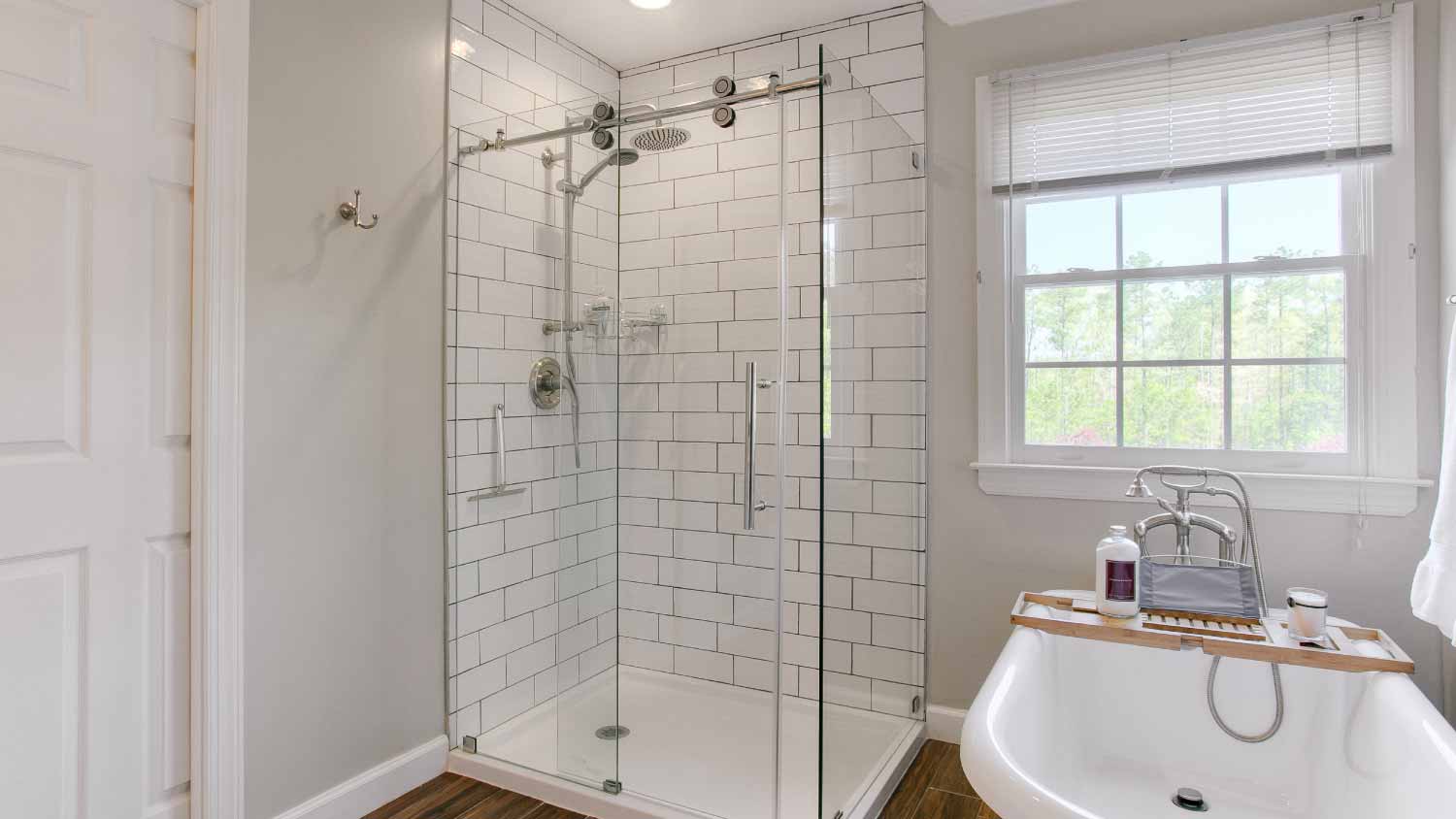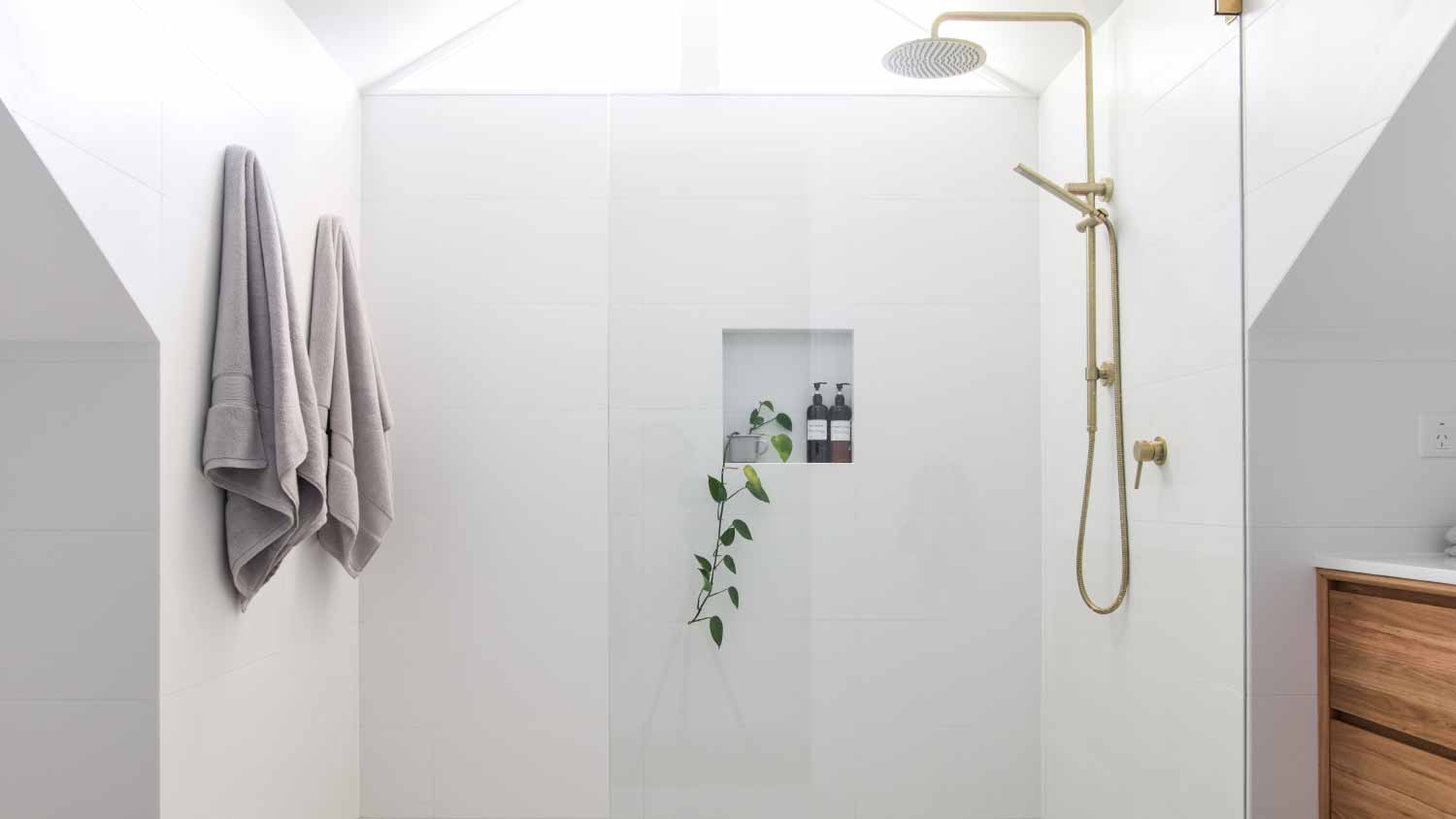
Remodeling your bathroom can add significant value to your home. Your bathroom remodel cost in Columbus, OH will depend on size, fixtures, materials, labor, and other factors.
Wait tile you see how these shower solutions can upgrade your bathroom


Walk-in showers are self-contained, less expensive, and easier to install.
Wet rooms are open-concept bathrooms with integrated showers.
Wet rooms cost more because they require complete waterproofing.
If you’re looking to splish, splash, and elevate your space with a bathroom upgrade, consider whether a walk-in shower or wet room might be right for you. A walk-in shower has an easy step-in entryway into the shower enclosure, while wet rooms are fully waterproofed bathrooms with integrated shower areas. Read on to learn more about these popular ways to bathe in luxury and what sets them apart.
Walk-in showers are shower enclosures with a low step or no step at the entrance. Most have a partition or half-wall instead of a traditional shower door or curtain, so they prevent water from splashing out but feel more open than standard shower stalls. They’re easier to install in existing bathrooms because they don’t need all-over waterproofing.
Wet room showers are not enclosed and the entire bathroom is waterproofed. Many have minimalist, open designs that include soaking tubs and high-end materials. The floor in wet rooms gently slopes toward a drain that removes water from the entire room. Wet rooms have a sleek, modern aesthetic, but wet room costs are higher.

Walk-in showers are enclosed shower areas that don't include a bathtub. Walk-in showers have a clean, streamlined look, a low- or zero-threshold entry, and a door is optional. Most include a shower tray or pan that channels water toward the drain, so they’re a smart choice for homeowners who want style, function, and easy maintenance. Let’s look closer at the pros and cons of walk-in showers.
| Pros | Cons |
|---|---|
| Easier and less costly to install | Require a shower tray or base |
| For large and small spaces | Less seamless than wet rooms |
| Can include custom features | Can limit accessibility |
| Easier to add to existing homes | Water can pool at the edges |
| Defined, enclosed shower area | More difficult to clean and maintain |
Best for:
Homeowners who want a beautiful but practical upgrade without major remodeling
Smaller bathrooms that need a space-efficient shower
Individuals who want a more traditional shower with an upscale touch
Walk-in showers are less expensive and easier to install than wet rooms because they don’t require extensive waterproofing. This makes them easier and faster to add to existing homes. Their flexible sizing lets them fit in standard bathrooms and maximizes floor space.
Homeowners who want a defined, more private shower prefer walk-in showers. These showers have walls and the option to add doors to keep water inside rather than splashing into the whole bathroom.
Because walk-in showers are similar to traditional showers, they have a tray or pan base. This keeps in water, but it prevents the floorplan from feeling as open like a wet room. While the shower enclosure makes cleaning easier, the shower curb and tighter layout can make access challenging for those who need more accessibility. Glass panels and doors need cleaning to avoid soap scum buildup, but walls can make the space harder to clean.
If the shower pan isn’t installed correctly, water can pool at the edges and corners, encouraging mold or mildew growth and creating slip hazards.

Wet room bathrooms are fully waterproofed bathrooms that integrate a shower into the larger space. Wet rooms are designed with floors that slope to guide water to a central drain, creating a seamless and open look. They can be luxurious and modern and are more accessible than walk-in showers.
| Pros | Cons |
|---|---|
| Fully waterproofed | Higher installation cost |
| Ultra-modern | Require extensive remodeling to add |
| Highly accessible | Surfaces can be slippery |
| Barrier-free to maximize space | The entire bathroom gets wet |
| Can increase home value | Need a lot of maintenance and cleaning |
Best for:
Luxury homes and high-end bathroom renovations
Homeowners who want more accessibility and modern design
Homes with larger bathrooms and open layouts
Wet rooms are totally waterproof by design, protecting them against water damage no matter how much you splash. Their minimalist, barrier-free design between the shower and the rest of the bathroom gives them a modern look and feel, making them perfect for people who need greater accessibility.
While wet rooms work well in large spaces, they also maximize space in smaller bathrooms. The open floor plan can make small bathrooms feel larger and more functional. Well-designed wet rooms increase home value and desirability, especially in markets where buyers are looking for upscale features. A local shower installer can help you create a wet room that adds value to your life now and value to your home later if you decide to sell.
The pros of wet rooms can easily become cons if they don’t fit your needs. Full waterproofing and sloped flooring are expensive to install, and converting existing bathrooms requires extensive remodeling, including plumbing and structural changes. If you want a luxury look, the costs of higher-end finishes add up quickly.
The beauty of wet room bathrooms is that everything can get wet, but surfaces get slippery, so choose nonslip flooring. Water, soap, and shampoo can splash and spatter around the entire bathroom, so you’ll need to do more maintenance and cleaning to prevent soap scum buildup, mildew, and clogged drains.
Which comes out on top in this shower showdown? Let’s compare the two and see which one cleans up in terms of appearance, durability, price, and more.
Walk-in showers are impressive, but wet rooms win the appearance battle. With open layouts and minimal barriers, even smaller rooms have ample space for sleek, modern touches. The full integration of bathroom elements stands out in luxury wet room designs.
Wet room bathrooms turn an entire room into a dream bathroom and shower combination. That means you can select colors, tiles, fixtures, and unique luxury items to integrate into one space. You can customize walk-in showers with designer tile, benches, multiple specialty showerheads, frameless glass, and other individualized touches.
When done right and fitted with quality materials, walk-in showers and wet rooms should hold up for years of regular use. Walk-in showers keep it clean and contained, but puddles are part of the plan with wet rooms. The 360-degree waterproofing makes wet rooms highly resistant to leaks and water damage.
Take the plunge on a bathroom remodel without breaking the bank. It’s no surprise that walk-in showers cost less to build than wet rooms. They tend to be smaller, more confined, and easier to install in existing homes. Plus, shower pans keep water contained, rather than requiring expensive modifications like sloping floors and specialty drains.
Unless you’re a seasoned remodeler, leave installing a wet room or walk-in shower to the pros. That said, walk-in showers are easier to install than wet rooms. They’re closer to a standard shower in design, so contractors and DIYers find them simpler to build. Wet rooms require a contractor with specialized skills to get the waterproofing, floor slope, and other details just right, so don’t try this yourself unless you’ve got the credentials.
Just like with installation, walk-in showers are easier to repair than wet rooms. It’s much simpler to replace a shower door or patch a small leak in the shower area than fix the waterproofing throughout a wet room.
Walk-in showers keep water in and hassle out. Even though they have more walls and corners than wet rooms, the water, soap scum, and mess is contained in the shower. This makes cleaning the shower faster and easier. They also have simpler plumbing and drainage systems and fewer components that require repairs or replacement.
Walk-in showers tend to use less water and materials, so they’re more eco-friendly than wet rooms. Choose water-saving fixtures and energy-efficient heating and lighting for a more sustaintable bathroom.
Wet rooms tend to cost more up front, but the potential return on investment is greater because they increase home value and attract buyer attention. This is most true in markets where homebuyers want luxury features. You can benefit from the price-boosting power of a wet room even if your home is modest, your area doesn’t have sky-high prices, or your wet room is small.
From average costs to expert advice, get all the answers you need to get your job done.

Remodeling your bathroom can add significant value to your home. Your bathroom remodel cost in Columbus, OH will depend on size, fixtures, materials, labor, and other factors.

The cost to add a bathroom takes into account whether it’s a half or full bath, square footage, plumbing, electrical, and more. Read on for a cost breakdown.

Here's a look at the cost to build a garage with an apartment on your property for a rental or in-law apartment.

Make choosing your toilet seat a cinch using this guide. Learn about different toilet seat types, shapes, materials, and features.

Knowing how to install a shower requires some skill and experience, but a shower enclosure installation is a doable DIY project if you follow some basic steps.

Replacing or installing an attic ladder provides a safe way to access your attic. Learn what factors affect attic ladder installation cost to help you budget.